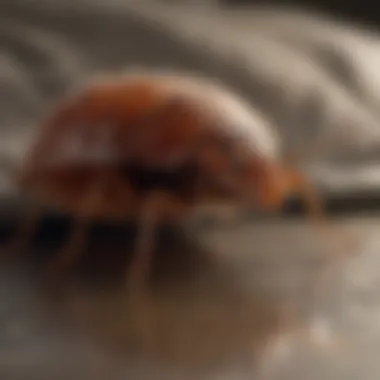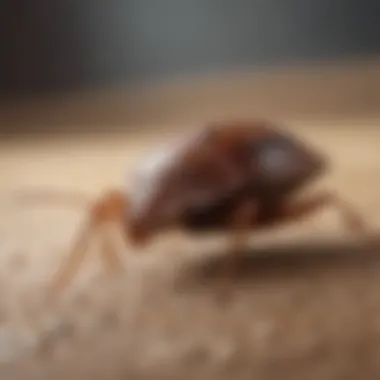Understanding Bed Bug Life Stages: A Comprehensive Guide


Intro
Bed bugs, scientifically known as Cimex lectularius, have become a growing concern in households worldwide. Their ability to adapt to various environments makes them resilient pests, often leading to widespread infestations. Understanding the life stages of bed bugs is critical for effective management and prevention. By exploring their biological processes from eggs to adults, we can identify strategies for keeping these pests at bay.
This section serves as a foundation for recognizing the pests, their habits, and the implications of infestations. Knowledge is power, especially when it comes to pest control.
Pest Identification
Common Household Pests
Bed bugs are not the only pests that may invade the home. Common household pests include cockroaches, ants, and termites. However, bed bugs stand out due to their distinct feeding behavior and life cycle. They are primarily nocturnal, feeding on human blood at night, which makes them elusive.
Signs of Infestation
Identifying bed bugs early can prevent a more serious infestation. Some key signs include:
- Visible Bugs: Adult bed bugs are about the size of an apple seed, brownish in color, and flat.
- Bite Marks: Often appear as small, red bumps, usually in clusters, on the skin.
- Fecal Stains: Dark spots on bedding or furniture, indicating droppings.
- Egg Casings: Small, yellowish-white eggs that may be found in crevices.
Understanding these signs can aid in quicker identification and response, reducing the risk of severe infestations.
Prevention Methods
Environmental Modifications
Preventing bed bugs from invading your home begins with environmental awareness. Here are some effective strategies:
- Reduce Clutter: Minimize areas where bed bugs can hide.
- Seal Cracks: Use caulk to seal gaps in walls, floors, and behind baseboards.
- Use Protective Covers: Mattress and box spring encasements can help deter bed bugs from residing in bedding.
Home Maintenance Tips
Regular maintenance can also discourage bed bugs. Consider these tips:
- Regular Inspections: Check for signs of bed bugs regularly, especially after traveling.
- Frequent Cleaning: Vacuuming carpets, upholstery, and hard-to-reach areas helps remove potential hiding spots. Be sure to dispose of the vacuum bag immediately.
- Laundry Practices: Wash bedding and clothing in hot water regularly, drying at high temperatures.
DIY Pest Control Solutions
Natural Remedies
For those who prefer natural solutions, certain remedies have shown effectiveness against bed bugs. Some options include:
- Diatomaceous Earth: This powder can be sprinkled in areas where bed bugs hide, causing dehydration upon contact.
- Essential Oils: Some oils, like tea tree or lavender, may repel bed bugs. Mixing with water and using as a spray can be beneficial.
DIY Traps and Barriers
Creating physical barriers can be a useful DIY approach. Here are some methods:
- Homemade Traps: Using sticky tape around beds can capture any wandering bugs.
- Bed Bug Interceptors: These can be placed under bed legs to catch bed bugs trying to climb up.
Understanding the life stages and behaviors of bed bugs allows for more effective pest management strategies. By being vigilant and proactive in identifying and preventing infestations, homeowners can protect their living spaces from these persistent pests.
Prelude to Bed Bugs
Bed bugs are small, blood-sucking insects that pose significant challenges for many households. Understanding their life stages is vital for effective identification and management of infestations. The complexity of their life cycle, from eggs to adults, necessitates a comprehensive approach to pest control. This segment sheds light on the biological processes of bed bugs, and why they matter in terms of prevention and eradication strategies.
Overview of Bed Bugs
Bed bugs belong to the family Cimicidae, with the most commonly encountered species being Cimex lectularius. These pests are nocturnal and tend to thrive in environments where humans reside, such as homes, hotels, and public transport. Adult bed bugs can reach up to five millimeters in length and have flat, oval bodies that turn reddish-brown after feeding. Their size makes them difficult to detect, allowing infestations to escalate unnoticed.
The presence of bed bugs does not necessarily indicate poor hygiene. They can spread through various means, including luggage, used furniture, or simply being carried on a person's clothes. Once established, they can reproduce rapidly, leading to a larger and more challenging infestation.
Awareness of bed bug characteristics, including their appearance and behavior, is the first step in managing their presence effectively. Understanding these factors can aid homeowners in recognizing signs of infestation early.


Importance of Understanding Life Stages
Recognizing the life stages of bed bugs is crucial for a few reasons. First, interventions and treatments must be timed correctly to disrupt their lifecycle effectively. For instance, bed bug eggs must be properly targeted, as they are resistant to many over-the-counter pesticides.
Second, knowledge of their development stages helps tailor pest management strategies. Bed bug eggs, nymphs, and adults each require different approaches for effective control. Understanding how long each stage takes can influence decisions on how frequently treatments should be applied and the appropriate methods to use.
Finally, comprehending environmental factors that support various life stages can offer insights into prevention. For example, maintaining a clean, clutter-free environment may inhibit breeding and supporting conditions for bed bugs to thrive.
"Effective pest management begins with a thorough understanding of the pest’s life cycle and its needs."
In summary, a detailed grasp of bed bugs and their life stages informs effective pest management practices, protecting homes and ensuring peace of mind.
Egg Stage
The egg stage is a crucial phase in the life cycle of bed bugs. Understanding how bed bug eggs develop and what environmental factors influence this stage can help homeowners take effective preventive measures. Eggs are the starting point of any infestation. Hence, recognizing them and knowing their characteristics can be beneficial when combating these pests.
Identification of Bed Bug Eggs
Bed bug eggs are small, typically measuring about 1 millimeter in length. They have an elongated, oval shape, resembling a grain of rice. Often, they are pearly white and can be somewhat difficult to spot in a cluttered environment. They are usually laid in clusters, often found in hidden crevices like mattress seams, furniture joints, or behind baseboards.
To identify bed bug eggs, one can look for those characteristics:
- Color: Usually white or transparent when freshly laid, they may appear slightly sticky, which allows them to adhere to surfaces.
- Size: About the size of a pinhead or smaller.
- Location: Commonly found where bed bugs hide or feed, such as near sleeping areas.
Proper identification of bed bug eggs can assist homeowners in early detection and prevention of infestations.
Egg Laying Habits
Female bed bugs are prolific, capable of laying up to 500 eggs in their lifetime. The process of laying eggs occurs generally within a week after a meal. Bed bugs tend to lay eggs in safe, dark spaces to ensure maximum protection from predators.
The laying habits include:
- Cluster Formation: Often, several eggs will be deposited in one location, which allows for efficient growth of a new generation.
- Temperature Influence: Warmer conditions can lead to faster egg production. Each female can lay eggs every few days, ensuring swift population growth.
Understanding these habits enables homeowners to effectively manage environments that might attract and sustain bed bug populations.
Environmental Conditions for Egg Development
The conditions surrounding bed bug eggs significantly affect their development. Optimal conditions include moderate to high temperatures and sufficient humidity.
Key conditions include:
- Temperature: Eggs develop best between 70°F and 90°F (21°C to 32°C). Temperatures lower than this can slow their development, whereas extreme heat can kill them.
- Humidity Level: High humidity levels, around 75% or above, are ideal for egg survival. In drier conditions, eggs may desiccate and perish before they can hatch.
By managing temperature and humidity within living spaces, owners can disrupt the life cycle of bed bugs effectively. This knowledge can help in creating an environment less conducive to egg laying and survival, reducing the risk of infestation.
Nymph Stage
The nymph stage of bed bugs is critical to understanding their life cycle. These immature bed bugs, which resemble smaller, lighter-colored adults, play a significant role in the perpetuation of the infestation within a dwelling. Grasping their characteristics, growth milestones, and time frame to reach adulthood is essential for effective pest management. This section will provide insights into the nymph stage, illustrating how it impacts both the behavior of bed bugs and the challenges faced during extermination efforts.
Description and Characteristics
Nymphs are bed bugs that have not yet reached maturity. After hatching from eggs, they undergo several molting phases before becoming adults. Nymphs typically go through five instars, which are developmental stages between molts. Each instar is distinguished by specific characteristics.
Nymphs are smaller, about the size of a poppy seed initially and grow larger with each molt. Their body is soft and has a slightly transparent appearance, often making them hard to spot. They have a reddish-brown color once they feed, making them resemble adults. Recognizing these features is crucial for early detection of infestations.
Growth Process Through Molting
The growth of nymphs is a fascinating process called molting. Bed bugs must feed on blood to successfully molt. Each molting occurs only after a blood meal, emphasizing the importance of understanding their feeding habits. During this process, they shed their exoskeleton, making room for a larger body.
This growth pattern can be summarized as follows:
- First Instar: This is soon after the nymph hatches. They are tiny and white.
- Subsequent Instars: As they feed and molt, each stage sees an increase in size and darker coloration.


Conditions are vital for successful molting. Extreme temperatures or lack of food can disrupt their growth, leading to a reduction in population if managed correctly.
Time Frame from Nymph to Adult
The time it takes for a nymph to develop into an adult can be influenced by various factors, including environmental conditions and the availability of food. Under optimal conditions, it usually takes about 5 to 6 weeks for a nymph to reach adulthood. Factors that can affect this timeline include:
- Temperature: Warmer temperatures can accelerate growth.
- Feeding Frequency: More frequent and adequate feeding results in faster maturation.
In a controlled environment, if given constant access to food, nymphs can develop more quickly. However, in a typical home setting, fluctuations might prolong their development.
Understanding the time frame aids in strategizing treatments effectively. Knowing when nymphs are likely to emerge as adults allows for targeted management tactics.
Adult Stage
Understanding the adult stage of bed bugs is crucial. This stage signifies the peak of their lifecycle, where they become fully developed and capable of reproduction. Recognizing adult bed bugs is important for effective pest management strategies and for identifying infestations early. Each adult bed bug can produce hundreds of eggs in their lifetime, which significantly impacts infestations if left unaddressed.
Identifying Adult Bed Bugs
Adult bed bugs are generally easy to identify due to their distinctive characteristics. They are typically brown and may appear as reddish after a recent blood meal. Adult bed bugs measure about 4 to 5 mm in length, roughly the size of an apple seed. They have a flattened oval shape, making them hard to spot in tight spaces. Here are some characteristics to consider:
- Color: Reddish-brown after feeding, lighter before.
- Shape: Flat and oval, with no wings.
- Legs: Six legs that allow them to move quickly.
- Eyes: Small but noticeable when closely observed.
With a keen eye, homeowners can learn to distinguish adult bed bugs from other pests or common debris, aiding in early identification and management efforts.
Reproductive Behavior and Lifespan
Adult bed bugs have a unique reproductive behavior that contributes to their rapid population growth. Female bed bugs can mate multiple times throughout their life. After mating, a female can lay anywhere from two to five eggs a day, summing up to a total of 200 to 500 eggs in her lifetime. The lifespan of an adult bed bug can range from several months to over a year, depending on environmental conditions. Key considerations include:
- Mating habits: Involves traumatic insemination, which is quite unusual among insects.
- Egg-laying: Often happens in hidden locations, such as beneath mattresses or inside furniture.
Understanding this behavior aids in creating effective control measures, as focusing on the reproductive aspects can greatly reduce bed bug populations.
Impact of Adult Bed Bugs on Infestation Management
The presence of adult bed bugs complicates infestation management. Once these bugs reach maturity, they become prolific breeders, challenging homeowners to address infestations promptly. Because adults can survive for months without feeding, managing specific interventions is necessary. Important factors include:
- Detection: Early identification is vital. Use of traps and regular inspections can catch an infestation early.
- Treatment: Tailoring treatments to target adults specifically, such as heat treatments or insecticides.
- Continuous monitoring: After treatment, ongoing checks are essential to prevent re-infestation.
Proper understanding of the adult stage is vital in pest management. Homeowners need to be aware of the behaviors, identification markers, and breeding patterns of adult bed bugs. This knowledge empowers them to take action and mitigate the risks associated with infestations.
By understanding the adult stage's significance, housewives and homeowners can better equip themselves to manage and control bed bug issues effectively.
Factors Influencing Bed Bug Life Stages
Understanding the factors influencing the life stages of bed bugs is crucial for effective pest management. Each life stage is affected by various external conditions that can either promote or inhibit their development. This knowledge is not merely academic; it has practical implications for preventing and controlling infestations. Therefore, addressing these factors can lead to more successful strategies against bed bugs.
Temperature and Humidity Effects
Temperature and humidity play a significant role in the growth and development of bed bugs. Bed bugs thrive in warm, humid environments, which facilitate their reproduction and movement.
- Temperature Range: The optimal temperature for bed bug activity typically ranges between 70°F to 82°F (21°C to 28°C). At these temperatures, bed bugs can reproduce and mature quickly. When temperatures drop below 50°F (10°C) or exceed 113°F (45°C), their development stalls, and they can even die if exposed to extreme conditions for prolonged periods.
- Humidity Levels: Humidity also impacts bed bugs. They require moisture to survive, and higher humidity levels can lead to a faster life cycle. Ideally, humidity levels should be between 40% and 80%. Below this range, bed bugs might struggle to survive and reproduce effectively.
By manipulating temperature and humidity levels in targeted environments, homeowners can create unfavorable conditions for bed bugs, thereby impeding their life cycle and effectiveness in control measures.
Feeding Requirements and Their Impact on Development
Feeding is an essential aspect of a bed bug's life cycle that heavily influences their growth stages. Bed bugs rely on blood meals for sustenance, which is critical for molting and reproduction.
- Blood Meal Necessity: Each nymph stage requires at least one blood meal to molt into the next stage. Adult bed bugs, too, must feed regularly to maintain their health. A lack of feeding can slow down their development significantly. For instance, if nymphs do not have access to blood meals, they may remain in their immature state for extended periods.
- Impact on Lifespan: Adult bed bugs can survive for several months without feeding, but the quality of their meals is also vital. If they feed sufficiently, their lifespan may extend considerably. Conversely, malnourished adults will not reproduce optimally, leading to diminished populations over time.
Recognizing the feeding patterns and requirements is essential for effectively targeting their life stages in pest management strategies. Ensuring regular monitoring and control of feeding areas can significantly reduce bed bug numbers.
Behavioral Patterns Throughout Life Stages


Understanding the behavioral patterns of bed bugs is crucial for effective pest management. These patterns influence how bed bugs interact with their environment and respond to control measures. Recognizing daily activities and habitat preferences can inform strategies to prevent and manage infestations. Additionally, understanding these behaviors helps identify the best times and methods for treatment.
Daily Activity Cycles
Bed bugs are primarily nocturnal creatures. Their activity typically peaks during nighttime hours when they emerge from hiding places to feed. This feeding routine is critical for their growth and reproductive success. The desire for blood, their primary food source, drives this nocturnal behavior.
The following are key points about their daily activity cycles:
- Feeding Timeframe: Adult bed bugs require to feed at least once every 5 to 10 days. Nymphs, in their growth stages, might feed more frequently.
- Resting Phase: During the day, bed bugs seek out cozy, dark locations where they stay hidden. Common hiding spots include crevices in furniture, seams in mattresses, and behind wall fixtures.
- Social Interaction: Although generally solitary, bed bugs may be found close together in hiding spots. This closeness generally occurs as they wait to feed or during molting stages.
"Understanding their nocturnal nature can help in devising a schedule for inspections and treatments."
Hiding and Seeking Habitats
Bed bugs exhibit distinct preferences when it comes to habitats. Their ability to hide is one of their most effective survival strategies. They prefer locations that offer minimal disturbance and close proximity to potential hosts.
Some characteristics of their hiding and seeking behaviors include:
- Hiding Locations: Bed bugs are adept at finding tight spaces. They often inhabit areas where they can easily blend in, such as the seams of mattresses, under cushions, and inside wall cracks.
- Habitat Preferences: They gravitate towards warm areas that are near human activity, often residing in bedrooms and living rooms. Highly trafficked areas can present increased risk for bed bug presence.
- Movement Patterns: When forced out of their hiding spaces, bed bugs can travel efficiently to find new habitats. They can crawl across surfaces or utilize hitchhiking behavior via luggage, clothing, and furniture.
In summary, understanding these behavioral patterns throughout their life stages gives essential insight into how bed bugs function. This knowledge aids homeowners in developing effective management strategies.
Implications for Pest Management
Understanding the various life stages of bed bugs is crucial for effective pest management. By grasping the biology and habits of bed bugs, home owners and housewives can develop more targeted and efficient control strategies. Each life stage, from egg to adult, influences the methods chosen for treatment and prevention.
Understanding Life Cycle for Effective Control
Bed bugs undergo five nymph stages before reaching adulthood. Each nymph stage requires a blood meal to molt into the next stage. For pest management, recognizing this life cycle allows for effective timing of interventions.
- Identification of Stage: Identifying which stage the infestation is in helps determine the approach. For example, egg and early nymph stages are more likely to be affected by certain treatments, while adults may require different solutions.
- Targeted Treatments: Pesticides may vary in effectiveness depending on the life stage. Some products work better against adults, while others may be more suitable for eggs or nymphs. This knowledge enables more effective use of chemical and non-chemical control methods.
- Seasonal Understanding: Also, bed bugs may have seasonal patterns that can influence populations. Recognizing these cycles can aid in preventive measures during peak times.
Timing Treatments Relative to Life Stages
Knowing when to administer treatment is vital. The timing should align with the most vulnerable life stage.
- Egg Stage: Treatments should target eggs during peak laying periods. This ensures that the next generation is minimized.
- Nymph Stage: Applying treatments when nymphs are present can reduce the numbers effectively, as they feed often and are more susceptible to control methods.
- Adult Stage: Adults can withstand some forms of treatment better than younger stages. Timing interventions when the adult population is higher, ideally when they are actively feeding, can enhance effectiveness.
Proper timing in pest management is essential; early detection and appropriate action can prevent larger infestations.
Epilogue
Understanding the life stages of bed bugs is essential for effective pest management. Each stage, from egg to adult, presents unique challenges and opportunities for control measures. The insights gathered about their biological processes help inform when and how to address infestations.
Key elements to consider include the specific conditions that favor each life stage and how these conditions can be manipulated to prevent further infestations. For instance, knowing that eggs develop optimally in warm and humid environments can guide interventions.
Benefits of understanding these life stages are manifold. Homeowners are better equipped to identify infestations early, strategize treatments, and ultimately reduce reliance on harmful pesticides. Additionally, by focusing on the nymph and adult stages, pest control efforts can be more tailored and timely.
An in-depth comprehension of bed bug life stages aids in establishing a clearer picture of their habits and habitats. This knowledge serves as a critical factor in enhancing total elimination efforts and preventing future infestations.
"Effective pest management relies on understanding the biology and behavior of the pest."
Considering these aspects whenever faced with or anticipating a bed bug problem provides a distinct advantage to homeowners and pest control professionals alike.
Summary of Key Insights
Throughout this article, we explored the life stages of bed bugs in detail.
- Bed bugs undergo several distinct life stages which include eggs, nymphs, and adults.
- Each stage presents specific identification traits and environmental requirements.
- The transitional process between nymphs to adults is critical for infestations to grow and spread.
- Temperature and humidity play significant roles in the development and survival of these pests.
- Effective pest management hinges on understanding their life stages, timing, and treatment methods accordingly.
By synthesizing these insights, homeowners can navigate the complexities of bed bug infestations more effectively.
Future Directions in Bed Bug Research
Looking ahead, research on bed bugs continues to evolve.
- Innovative control methods are at the forefront, with scientists exploring biological controls that might reduce reliance on chemical treatments.
- Understanding genetic resistance in bed bugs could open pathways to new and more effective treatment options.
- Greater emphasis is being placed on how bed bugs adapt to varying environmental conditions. This can inform future containment and eradication strategies.
- Research into behavioral patterns and how they affect infestation dynamics could lead to more refined approaches to monitoring and managing bed bug populations.
As we advance, keeping an eye on these future directions will be key to addressing bed bug issues comprehensively and effectively, ensuring that homeowners can better protect their spaces.















